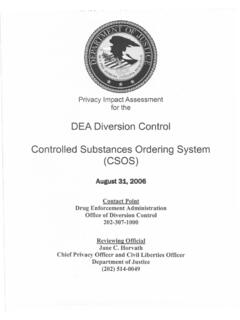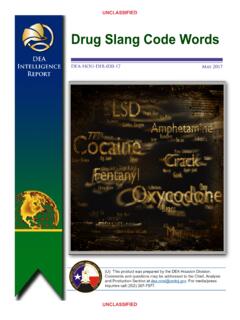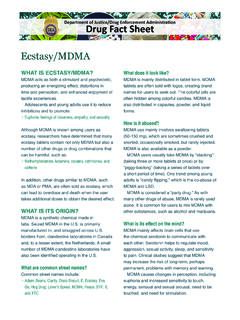Transcription of Drug Fact Sheet - DEA.gov
1 MarijuanaOverviewMarijuana is a mind-altering (psychoactive) drug, produced by the Cannabis sativa plant. Marijuana contains over 400 chemicals. THC (delta-9-tetrahydrocannabinol) is believed to be the main chemical ingredient that produces the psychoactive namesAunt Mary, BC Bud, Blunts, Boom, Chronic, Dope, Gangster, Ganja, Grass, Hash, Herb, Hydro, Indo, Joint, Kif, Mary Jane, Mota, Pot, Reefer, Sinsemilla, Skunk, Smoke, Weed, YerbaLooks likeMarijuana is a dry, shredded green/brown mix of flowers, stems, seeds, and leaves from the Cannabis sativa plant. The mixture typically is green, brown, or gray in color and may resemble of abuseMarijuana is usually smoked as a cigarette (called a joint) or in a pipe or bong. It is also smoked in blunts, which are cigars that have been emptied of tobacco and refilled with marijuana, sometimes in combination with another drug.
2 Marijuana is also mixed with foods or brewed as a on mindWhen marijuana is smoked, the THC passes from the lungs and into the bloodstream, which carries the chemical to the organs throughout the body, including the brain. In the brain, the THC connects to specific sites called cannabinoid receptors on nerve cells and influences the activity of those cells. Many of these receptors are found in the parts of the brain that influence pleasure, memory, thought, concentration, sensory and time perception, and coordinated movement. The short-term effects of marijuana include problems with memory and learning, distorted perception, difficulty in thinking and problem-solving, and loss of coordination. The effect of marijuana on perception and coordination are responsible for serious impairments in driving abilities. Long-term chronic marijuana use is associated with Amotivational Syndrome, characterized by apathy, impairment of judgment, memory and concentration, and loss of motivation, ambition and interest in the pursuit of personal goals.
3 High doses of marijuana can result in mental confusion, panic reactions and hallucinations. Researchers have also found an association between marijuana use and an increased risk of depression; an increased risk and earlier onset of schizophrenia and other psychotic disorders, especially for teens that have a genetic on bodyShort-term physical effects from marijuana use may include sedation, blood shot eyes, increased heart rate, coughing from lung irritation, increased appetite, and decreased blood pressure. Like tobacco smokers, marijuana smokers experience serious health problems such as bronchitis, emphysema, and bronchial asthma. Extended use may cause suppression of the immune system. Because marijuana contains toxins and carcinogens, marijuana smokers increase their risk of cancer of the head, neck, lungs and respiratory track.
4 Withdrawal from chronic use of high doses of marijuana causes physical signs including headache, shakiness, sweating, stomach pains and nausea, as well as behavioral signs including restlessness, irritability, sleep difficulties and decreased causing similar effectsHashish and hashish oil are drugs made from the cannabis plant that are like marijuana, only stronger. Hashish (hash) consists of the THC - rich resinous material of the cannabis plant, which is collected, dried, and then compressed into a variety of forms, such as balls, cakes, or cookie like sheets. Pieces are then broken off, placed in pipes or mixed with tobacco and placed in pipes or cigarettes, or smoked. The main sources of hashish are the Middle East, North Africa, Pakistan and Oil (hash oil, liquid hash, cannabis oil) is produced by extracting the cannabinoids from the plant material with a solvent.
5 The color and odor of the extract will vary, depending on the solvent used. A drop or two of this liquid on a cigarette is equal to a single marijuana joint. Like marijuana, hashish and hashish oil are both Schedule I drugs. Overdose effectsNo death from overdose of marijuana has been status in the United StatesMarijuana is a Schedule I substance under the Controlled Substances Act. Schedule I drugs are classified as having a high potential for abuse, no currently accepted medical use in treatment in the United States, and a lack of accepted safety for use of the drug or other substance under medical supervision. Marinol, a synthetic version of THC, the active ingredient found in the marijuana plant, can be prescribed for the control of nausea and vomiting caused by chemotherapeutic agents used in the treatment of cancer and to stimulate appetite in AIDS patients.
6 Marinol is a Schedule III substance under the Controlled Substances Act. Schedule III drugs are classified as having less potential for abuse than the drugs or substances in Schedules I and II, and have a currently accepted medical use in treatment in the , and abuse of the drug may lead to moderate or low physical dependence or psychological places of originMarijuana is grown in the United States, Canada, Mexico, South America and Asia. It can be cultivated in both outdoor and in indoor content came from a United States Government, Drug Enforcement Administration (DEA) website, Fact SheetDrug Enforcement Administration For more information, visit is a mind-altering (psychoactive) drug, produced by the Cannabis sativa plant. Marijuana contains over 400 chemicals. THC (delta-9-tetrahydrocannabinol) is believed to be the main chemical ingredient that produces the psychoactive namesAunt Mary, BC Bud, Blunts, Boom, Chronic, Dope, Gangster, Ganja, Grass, Hash, Herb, Hydro, Indo, Joint, Kif, Mary Jane, Mota, Pot, Reefer, Sinsemilla, Skunk, Smoke, Weed, YerbaLooks likeMarijuana is a dry, shredded green/brown mix of flowers, stems, seeds, and leaves from the Cannabis sativa plant.
7 The mixture typically is green, brown, or gray in color and may resemble of abuseMarijuana is usually smoked as a cigarette (called a joint) or in a pipe or bong. It is also smoked in blunts, which are cigars that have been emptied of tobacco and refilled with marijuana, sometimes in combination with another drug. Marijuana is also mixed with foods or brewed as a on mindWhen marijuana is smoked, the THC passes from the lungs and into the bloodstream, which carries the chemical to the organs throughout the body, including the brain. In the brain, the THC connects to specific sites called cannabinoid receptors on nerve cells and influences the activity of those cells. Many of these receptors are found in the parts of the brain that influence pleasure, memory, thought, concentration, sensory and time perception, and coordinated movement.
8 The short-term effects of marijuana include problems with memory and learning, distorted perception, difficulty in thinking and problem-solving, and loss of coordination. The effect of marijuana on perception and coordination are responsible for serious impairments in driving abilities. Long-term chronic marijuana use is associated with Amotivational Syndrome, characterized by apathy, impairment of judgment, memory and concentration, and loss of motivation, ambition and interest in the pursuit of personal goals. High doses of marijuana can result in mental confusion, panic reactions and hallucinations. Researchers have also found an association between marijuana use and an increased risk of depression; an increased risk and earlier onset of schizophrenia and other psychotic disorders, especially for teens that have a genetic on bodyShort-term physical effects from marijuana use may include sedation, blood shot eyes, increased heart rate, coughing from lung irritation, increased appetite, and decreased blood pressure.
9 Like tobacco smokers, marijuana smokers experience serious health problems such as bronchitis, emphysema, and bronchial asthma. Extended use may cause suppression of the immune system. Because marijuana contains toxins and carcinogens, marijuana smokers increase their risk of cancer of the head, neck, lungs and respiratory track. Withdrawal from chronic use of high doses of marijuana causes physical signs including headache, shakiness, sweating, stomach pains and nausea, as well as behavioral signs including restlessness, irritability, sleep difficulties and decreased causing similar effectsHashish and hashish oil are drugs made from the cannabis plant that are like marijuana, only stronger. Hashish (hash) consists of the THC - rich resinous material of the cannabis plant, which is collected, dried, and then compressed into a variety of forms, such as balls, cakes, or cookie like sheets.
10 Pieces are then broken off, placed in pipes or mixed with tobacco and placed in pipes or cigarettes, or smoked. The main sources of hashish are the Middle East, North Africa, Pakistan and Oil (hash oil, liquid hash, cannabis oil) is produced by extracting the cannabinoids from the plant material with a solvent. The color and odor of the extract will vary, depending on the solvent used. A drop or two of this liquid on a cigarette is equal to a single marijuana joint. Like marijuana, hashish and hashish oil are both Schedule I drugs. Overdose effectsNo death from overdose of marijuana has been status in the United StatesMarijuana is a Schedule I substance under the Controlled Substances Act. Schedule I drugs are classified as having a high potential for abuse, no currently accepted medical use in treatment in the United States, and a lack of accepted safety for use of the drug or other substance under medical supervision.

















